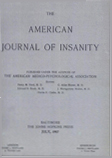THE EFFECT OF INTERCURRENT CHRONIC PULMONARY TUBERCULOSIS ON THE CONVULSION THRESHOLD IN EPILEPSY
Abstract
1. Investigation seems to indicate that epilepsy does not predispose to chronic pulmonary tuberculosis, nor vice versa.
2. In a series of one hundred cases of epilepsy with intercurrent chronic pulmonary tuberculosis in its active stages, the frequency of seizures was markedly decreased in the majority of cases, with a demonstrable loss of weight.
3. A review of the literature reveals the following:
(a) That there is a reduced basal metabolic rate in epilepsy and a definitely increased rate in pulmonary tuberculosis.
(b) That convulsions are often absent in diseases with a high blood sugar such as diabetes and cancer and that hyperglycemia tends to occur in the tuberculous individual.
(c) That a normal blood-serum calcium is usually found in epilepsy and that it is often found to be elevated in pulmonary tuberculosis.
(d) That a reduction in the sodium chloride of the blood of epileptics often reduces the frequency of convulsions and that a constantly low blood chloride is often found in patients with active pulmonary tuberculosis.
(e) That comparisons of the blood pictures in epilepsy and in pulmonary tuberculosis show the occurrence of hypocholestemia and an increased rate of sedimentation of the blood in both conditions.
(f) That the Ph values of the blood seem to indicate a tendency in the epileptic to approach a more alkaline reaction, and in the tuberculous patient a more acid reaction.
4. From the above data suggestions are made as to the mechanism involved in active chronic pulmonary tuberculosis in raising the convulsion threshold in preexisting epilepsy so that the frequency of seizures is noticeably reduced.
5. The multiplicity of possible solutions is itself proof that no satisfactory single solution can be found at the present time.
Access content
To read the fulltext, please use one of the options below to sign in or purchase access.- Personal login
- Institutional Login
- Sign in via OpenAthens
- Register for access
-
Please login/register if you wish to pair your device and check access availability.
Not a subscriber?
PsychiatryOnline subscription options offer access to the DSM-5 library, books, journals, CME, and patient resources. This all-in-one virtual library provides psychiatrists and mental health professionals with key resources for diagnosis, treatment, research, and professional development.
Need more help? PsychiatryOnline Customer Service may be reached by emailing [email protected] or by calling 800-368-5777 (in the U.S.) or 703-907-7322 (outside the U.S.).



